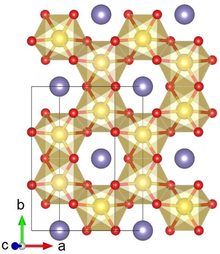| |||
 | |||
 | |||
| Names | |||
|---|---|---|---|
| Preferred IUPAC name Lithium iridate | |||
| Identifiers | |||
| CAS Number | |||
| 3D model (JSmol) | |||
InChI
| |||
SMILES
| |||
| Properties | |||
| Chemical formula | Li2IrO3 | ||
| Appearance | Black crystals | ||
| Structure | |||
| Crystal structure | Monoclinic, C2/m | ||
| Lattice constant | a = 5.1633(2) Å, b = 8.9294(3) Å, c = 5.1219(2) Åα = 90°, β = 109.759(3)°, γ = 90° | ||
| Formula units (Z) | 4 | ||
| Related compounds | |||
| Other anions | Lithium ruthenate, lithium platinate | ||
| Other cations | Sodium iridate | ||
| Except where otherwise noted, data are given for materials in their standard state (at 25 °C , 100 kPa).
| |||
Lithium iridate, Li2IrO3, is a chemical compound of lithium, iridium and oxygen. It forms black crystals with three slightly different layered atomic structures, α, β, and sometimes γ. Lithium iridate exhibits metal-like, temperature-independent electrical conductivity, and changes its magnetic ordering from paramagnetic to antiferromagnetic upon cooling to 15 K.
Structure
Li2IrO3 typically crystallizes in the α or β phase, and a rare γ phase has been reported. The crystal structure of α-Li2IrO3 consists of an alternate stacking of hexagonal Li layers and honeycombs of edge-sharing IrO6 octahedra with Li in the center. The offset in adjacent layers results in a relatively low (monoclinic) crystal symmetry. Li2IrO3 crystals have abundant twinning defects where the ab crystal planes are rotated by 120° around the c axis.
Synthesis


Li2IrO3 crystals can be grown by direct sintering of Ir and Li metals, which both oxidize during heating in ambient atmosphere. The α phase is formed at 750–1050 °C, while heating to higher temperatures results in the β phase. The use of Li metal instead of more traditional lithium carbonate, which is easier to handle and store, results in larger crystals. The γ phase can be obtained by the calcination of lithium carbonate and iridium(IV) oxide, followed by annealing in molten lithium hydroxide at 700–800 °C.
Properties
Lithium iridate is black in color and has a relatively high, temperature-independent electrical conductivity characteristic of metals. Its both α and β phases exhibit the Kitaev exchange coupling between magnetic spins originating from Ir ions. These spins form an antiferromagnetic lattice at temperatures below 15 K (Néel temperature, TN), while the material is paramagnetic above TN.
Potential applications
Lithium iridate is a potential electrode material for the lithium-ion battery. This application is hindered by the high costs of Ir, as compared to the cheaper Li2MnO3 alternative.
References
- ^ Freund, F.; Williams, S. C.; Johnson, R. D.; Coldea, R.; Gegenwart, P.; Jesche, A. (2016). "Single crystal growth from separated educts and its application to lithium transition-metal oxides". Scientific Reports. 6: 35362. arXiv:1604.04551. Bibcode:2016NatSR...635362F. doi:10.1038/srep35362. PMC 5066249. PMID 27748402.
- ^ O'Malley, Matthew J.; Verweij, Henk; Woodward, Patrick M. (2008). "Structure and properties of ordered Li2IrO3 and Li2PtO3". Journal of Solid State Chemistry. 181 (8): 1803. Bibcode:2008JSSCh.181.1803O. doi:10.1016/j.jssc.2008.04.005.
- Yoshio, Masaki; Brodd, Ralph J.; Kozawa, Akiya (17 July 2010). Lithium-Ion Batteries: Science and Technologies. Springer Science & Business Media. p. 10. ISBN 978-0-387-34445-4.
| Iridium compounds | |||
|---|---|---|---|
| Iridium(0) | |||
| Iridium(I) |
| ||
| Iridium(II) | |||
| Iridium(III) |
| ||
| Iridium(IV) | |||
| Iridium(V) | |||
| Iridium(VI) | |||
| Iridium(VII) | |||
| Iridium(VIII/IX) |
| ||

